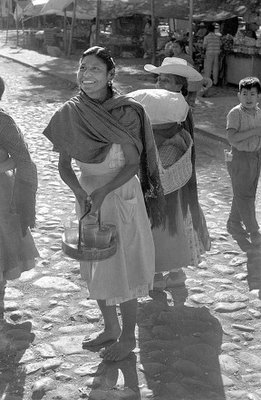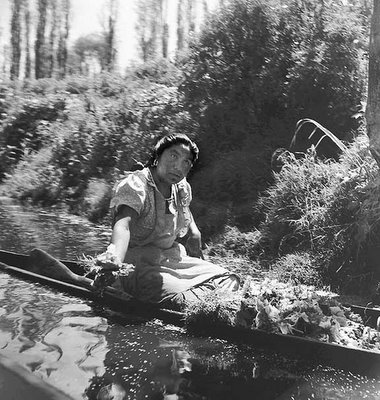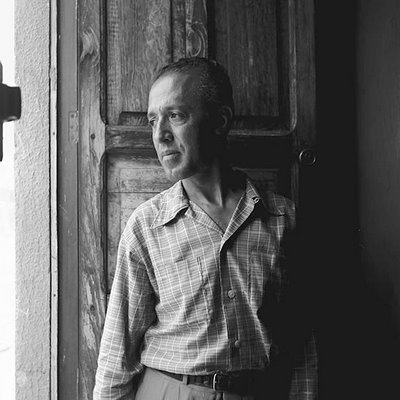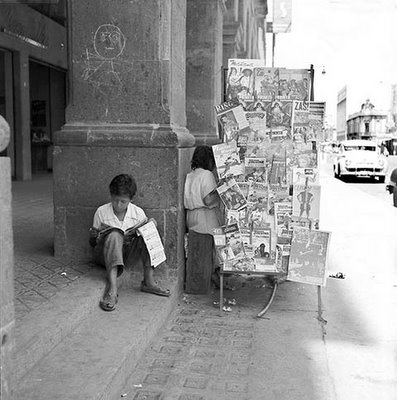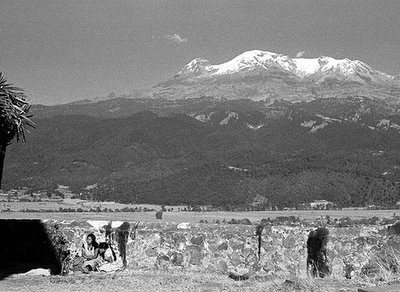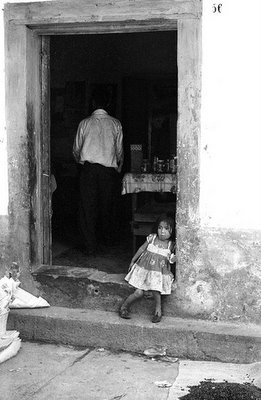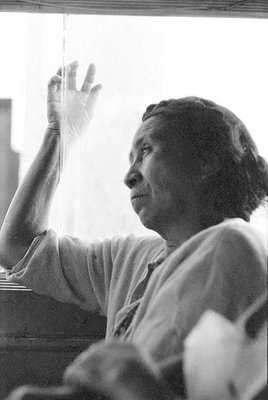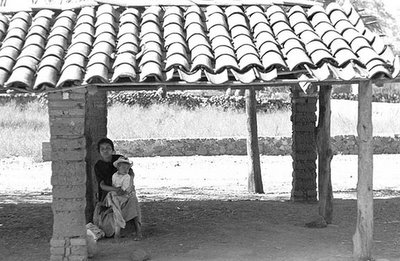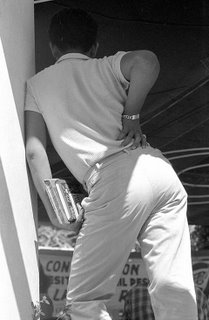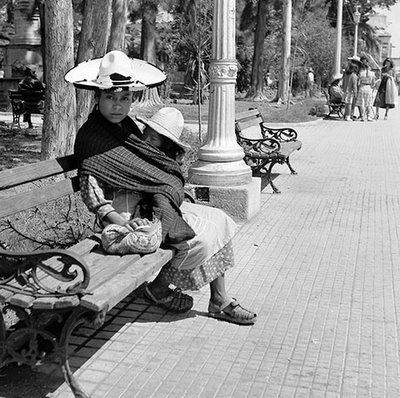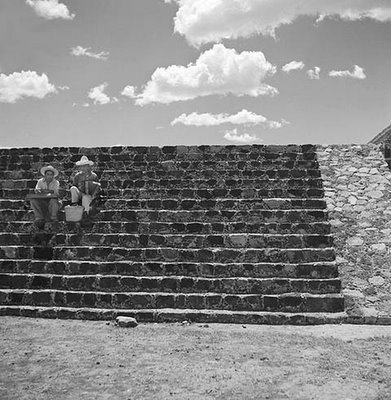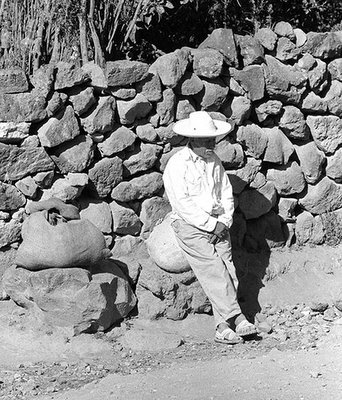Saturday, April 05, 2008
An exhibition of 72 of the prints from this collection takes place May 8 through 31, 2008, at the Escuela de Artes Plasticos, Instituto Cultural Cabanas, Guadalajara.
Thursday, April 06, 2006
The book of photographs sampled below begins with this preface:
As a very young man I made many photographs of Mexico. Those here are mostly from 1953, a few from 1959. I found the country beautful, mysterious, and touching. I had experiences there that proved the generous and trusting nature of Mexican people.
It was a poor but hopeful nation. Ouside the capital, which was excitingly building a new downtown and a glamorous International Style university campus near the city, people’s lives were slower. Everyone seemed to be waiting — for a bus, for work, for harvest, for a customer, and, I felt, for the promise of the revolution to be fulfilled. All their beautiful art which integrated their past and their present was promising them that.
This was before decades of political corruption were exposed, and headlines revealed the drug traffic, the murderous syndicates of the border cities, the kidnapping gangs and hijacking cabs of the capitol, and the decay of the nation’s police and justice system. Mexican people grew less hopeful for their nation, and economic crises sent many fleeing across the northern border to find work and feed their families. I have returned to Mexico many times since the fifties, feeling growing alarm.
Mexico’s magic, that I hope may help save it, is its closeness to its native people’s roots and its pride in them. The pre-European past is celebrated everywhere. That is the first thing that shocks North and some South Americans, whose native cultures were nearly erased. The native tradition was resilient and tough. Central Mexico was the most densely populated place on earth a thousand years ago, and its people were so organized that they could build bigger and cleaner cities than Europe had. Spain did not defeat the Mexica: smallpox did, and the political disunity caused by their harsh theology that required constant war to acquire captives for human sacrifice to keep the sun in the sky.
Mexicans remember, because of art and education, their exploitation by the rulers and priests of that theology six hundred years ago, as well as that of four hundred and two hundred years ago, and it gives them perspective on the ways of ruling classes today and tomorrow. I hope that their historical sense of identity and of who does what to whom will enable the Mexican nation to persist into a finer time, when we of the north, who ignore our roots, drink down what is passed around, and think all has been made new, will wonder how they did it.
I have returned to these long-stored negatives to recall the Mexico just a generation out of its revolution that a young German-English-Polish American fell in love with, half a century ago. That seems like a short span to me now. Ten of those spans would put us at 1500, when Mexico City was called Tenochtitlan.
As a very young man I made many photographs of Mexico. Those here are mostly from 1953, a few from 1959. I found the country beautful, mysterious, and touching. I had experiences there that proved the generous and trusting nature of Mexican people.
It was a poor but hopeful nation. Ouside the capital, which was excitingly building a new downtown and a glamorous International Style university campus near the city, people’s lives were slower. Everyone seemed to be waiting — for a bus, for work, for harvest, for a customer, and, I felt, for the promise of the revolution to be fulfilled. All their beautiful art which integrated their past and their present was promising them that.
This was before decades of political corruption were exposed, and headlines revealed the drug traffic, the murderous syndicates of the border cities, the kidnapping gangs and hijacking cabs of the capitol, and the decay of the nation’s police and justice system. Mexican people grew less hopeful for their nation, and economic crises sent many fleeing across the northern border to find work and feed their families. I have returned to Mexico many times since the fifties, feeling growing alarm.
Mexico’s magic, that I hope may help save it, is its closeness to its native people’s roots and its pride in them. The pre-European past is celebrated everywhere. That is the first thing that shocks North and some South Americans, whose native cultures were nearly erased. The native tradition was resilient and tough. Central Mexico was the most densely populated place on earth a thousand years ago, and its people were so organized that they could build bigger and cleaner cities than Europe had. Spain did not defeat the Mexica: smallpox did, and the political disunity caused by their harsh theology that required constant war to acquire captives for human sacrifice to keep the sun in the sky.
Mexicans remember, because of art and education, their exploitation by the rulers and priests of that theology six hundred years ago, as well as that of four hundred and two hundred years ago, and it gives them perspective on the ways of ruling classes today and tomorrow. I hope that their historical sense of identity and of who does what to whom will enable the Mexican nation to persist into a finer time, when we of the north, who ignore our roots, drink down what is passed around, and think all has been made new, will wonder how they did it.
I have returned to these long-stored negatives to recall the Mexico just a generation out of its revolution that a young German-English-Polish American fell in love with, half a century ago. That seems like a short span to me now. Ten of those spans would put us at 1500, when Mexico City was called Tenochtitlan.
Monday, March 06, 2006
Thursday, February 23, 2006
from the preface....
It was a poor but hopeful nation. Outside the capital, which was excitingly building a new downtown and a glamorous International Style university campus near the city, people's lives were slower. Everyone seemed to be waiting -- for a bus, for work, for harvest, for a customer, and I felt, for the promise of the revolution to be fulfilled. All their beautiful art which integrated their past and their present was promising them that.
The Photographs of "Mexico 1953"
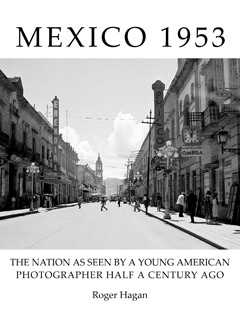
------- The photographs in the book designed to accompany the exhibition are organized in six portfolios. The first one is entitled "Waiting" because of the words shown above from the Preface.
This sampling of photographs from "Mexico 1953" is drawn from the first portfolio. The six portfolios are entitled:
- Waiting
- In Cities
- Among Ruins
- Under Volcanos
- In the Country
- More Faces
